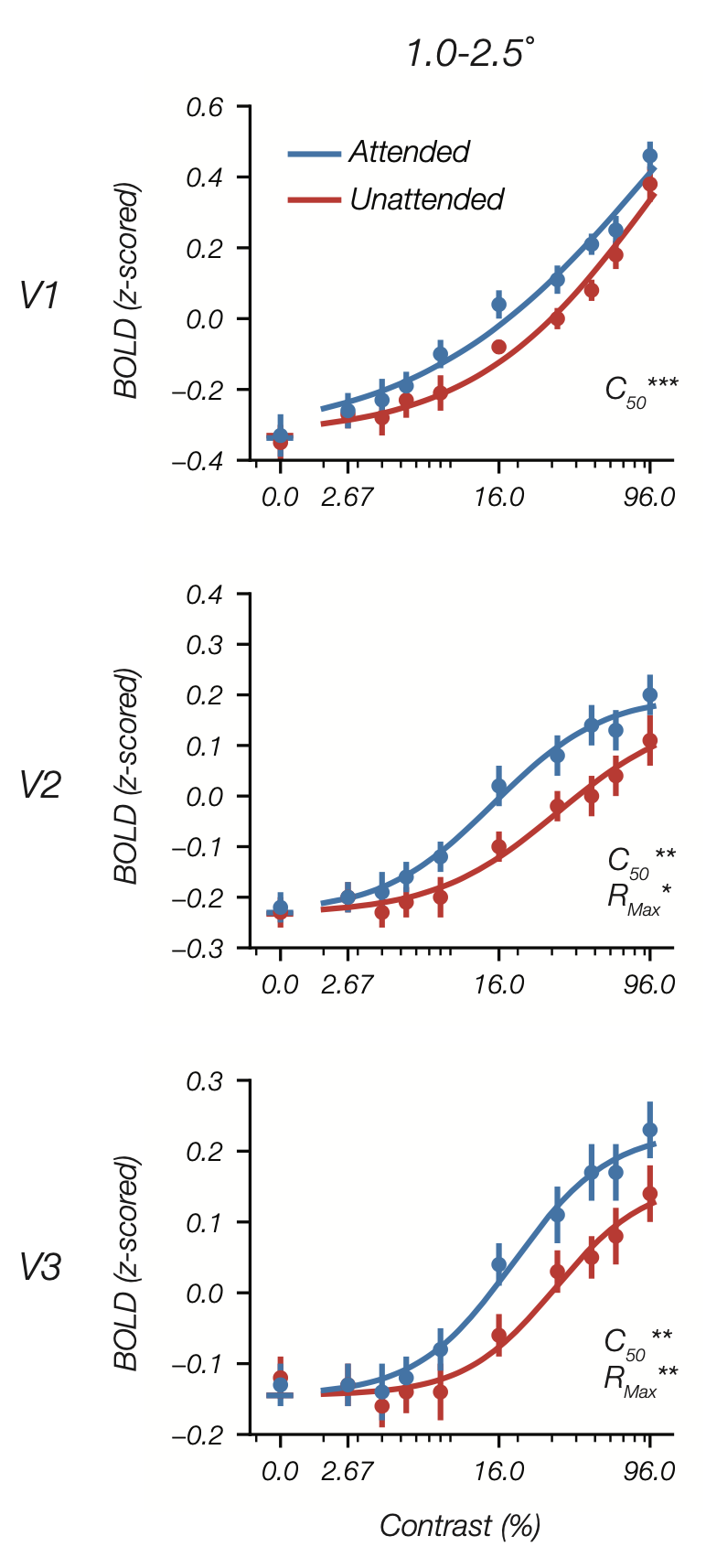Feature-based attention multiplicatively scales the fMRI-BOLD contrast-response function
Journal of Neuroscience (2022)
Joshua Foster & Sam Ling
 Functional MRI (fMRI) plays a key role in the study of attention. However, there remains a puzzling discrepancy between attention effects measured with fMRI and with electrophysiological methods. While electrophysiological studies find that attention increases sensory gain, amplifying stimulus-evoked neural responses by multiplicatively scaling the contrast-response function (CRF), fMRI appears to be insensitive to these multiplicative effects. Instead, fMRI studies typically find that attention produces an additive baseline shift in the blood-oxygen-level-dependent (BOLD) signal. These findings suggest that attentional effects measured with fMRI reflect top-down inputs to visual cortex, rather than the modulation of sensory gain. If true, this drastically limits what fMRI can tell us about how attention improves sensory coding. Here, we examined whether fMRI is sensitive to multiplicative effects of attention using a feature-based attention paradigm designed to preclude any possible additive effects. We measured BOLD activity evoked by a probe stimulus in one visual hemifield while participants (6 male, 6 female) attended to the probe orientation (attended condition), or to an orthogonal orientation (unattended condition), in the other hemifield. To measure CRFs in visual areas V1-V3, we parametrically varied the contrast of the probe stimulus. In all three areas, feature-based attention increased contrast gain, improving sensitivity by shifting CRFs towards lower contrasts. In V2 and V3, we also found an increase in response gain, an increase in the responsivity of the CRF, that was greatest at inner eccentricities. These results provide clear evidence that the fMRI-BOLD signal is sensitive to multiplicative effects of attention.
Functional MRI (fMRI) plays a key role in the study of attention. However, there remains a puzzling discrepancy between attention effects measured with fMRI and with electrophysiological methods. While electrophysiological studies find that attention increases sensory gain, amplifying stimulus-evoked neural responses by multiplicatively scaling the contrast-response function (CRF), fMRI appears to be insensitive to these multiplicative effects. Instead, fMRI studies typically find that attention produces an additive baseline shift in the blood-oxygen-level-dependent (BOLD) signal. These findings suggest that attentional effects measured with fMRI reflect top-down inputs to visual cortex, rather than the modulation of sensory gain. If true, this drastically limits what fMRI can tell us about how attention improves sensory coding. Here, we examined whether fMRI is sensitive to multiplicative effects of attention using a feature-based attention paradigm designed to preclude any possible additive effects. We measured BOLD activity evoked by a probe stimulus in one visual hemifield while participants (6 male, 6 female) attended to the probe orientation (attended condition), or to an orthogonal orientation (unattended condition), in the other hemifield. To measure CRFs in visual areas V1-V3, we parametrically varied the contrast of the probe stimulus. In all three areas, feature-based attention increased contrast gain, improving sensitivity by shifting CRFs towards lower contrasts. In V2 and V3, we also found an increase in response gain, an increase in the responsivity of the CRF, that was greatest at inner eccentricities. These results provide clear evidence that the fMRI-BOLD signal is sensitive to multiplicative effects of attention.

